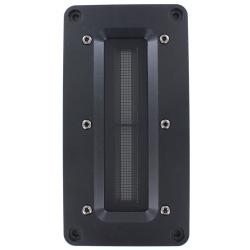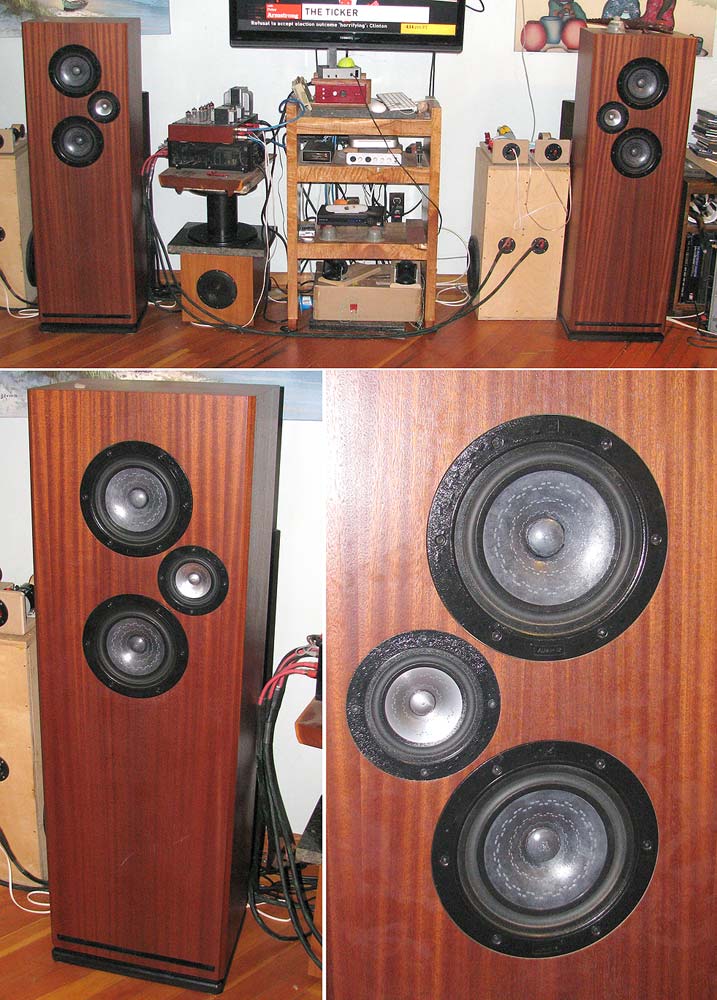Depending on the application, it's usually best to place them close to each other. Sometimes 3-ways have a woofer near the floor to negate some of the BSC loss.
In most cases, I feel that spacing should be within one wavelength (not 1/4 lambda) CTC at the xover frequency. For example, a 2kHz xover is about 6", and you cannot get your average 2-way closer than that in most cases. The further you are positioned from the speakers also benefits the blending process.
You can fudge the CTC figure a smidge and get away with it at times. I've done a 3kHz xover with a 6" spread CTC, which is not optimal, but it did work okay. What you run into is 'stretching' the image if they get too far apart. For instance if a woman is singing, and goes up in range, and it sounds as though her voice physically stands up higher in the image, then they are either too far apart, there's a hole in the blend at the xover, or they are xovered too high.
Later,
Wolf
In most cases, I feel that spacing should be within one wavelength (not 1/4 lambda) CTC at the xover frequency. For example, a 2kHz xover is about 6", and you cannot get your average 2-way closer than that in most cases. The further you are positioned from the speakers also benefits the blending process.
You can fudge the CTC figure a smidge and get away with it at times. I've done a 3kHz xover with a 6" spread CTC, which is not optimal, but it did work okay. What you run into is 'stretching' the image if they get too far apart. For instance if a woman is singing, and goes up in range, and it sounds as though her voice physically stands up higher in the image, then they are either too far apart, there's a hole in the blend at the xover, or they are xovered too high.
Later,
Wolf
Thanks so much for the great info Dave and Wolf!!!
Crossover points are envisioned to be ~ 200-300hz and around 5k.
(first order except woofer LP)
It seems like a quater wave's distance apart is a bit unrealistic, so stretching of another sort comes into play.... stretching quarter wave into a full wave's distance for instance...
Even then it's tough..
At 200-300 hz, you'd have to mount the mid into the woofer's come LOL..
So I guess for 5k the tweet/mid spacing would be around 3 inches at full wavelength if I've done my calcs correctly... that would mean the drivers literally touching..
FWIW the project is a 3-way OB with 12" woofer, Dynavox T-215-RTF-64 - 8 Ω as mid, and this ribbon up top (Fountek 2.0):

So for a 12" woofer with a Q a bit to low for OB.... how far from the bottom of the baffle-board to make up for as much as possible for the low Q?
Also, is the "center" of the ribbon the midpoint in the vertical plane?
Wondering if there's a downside to just putting them all adjacent... other than if seated at an unusually great distance.. and/or causing the tweeter height to be much lower than ear level, assuming the woofer close to the floor...
Any other suggestions for this project would be MOST welcome!
Thanks again,
Greg
Crossover points are envisioned to be ~ 200-300hz and around 5k.
(first order except woofer LP)
It seems like a quater wave's distance apart is a bit unrealistic, so stretching of another sort comes into play.... stretching quarter wave into a full wave's distance for instance...
Even then it's tough..
At 200-300 hz, you'd have to mount the mid into the woofer's come LOL..
So I guess for 5k the tweet/mid spacing would be around 3 inches at full wavelength if I've done my calcs correctly... that would mean the drivers literally touching..
FWIW the project is a 3-way OB with 12" woofer, Dynavox T-215-RTF-64 - 8 Ω as mid, and this ribbon up top (Fountek 2.0):

So for a 12" woofer with a Q a bit to low for OB.... how far from the bottom of the baffle-board to make up for as much as possible for the low Q?
Also, is the "center" of the ribbon the midpoint in the vertical plane?
Wondering if there's a downside to just putting them all adjacent... other than if seated at an unusually great distance.. and/or causing the tweeter height to be much lower than ear level, assuming the woofer close to the floor...
Any other suggestions for this project would be MOST welcome!
Thanks again,
Greg
1/4 wave length is usually impossible where this really matters. Best to design with simulator (VituixCAD) which is able to combine directivity and vertical locations of the drivers and crossover into power response and vertical off-axis responses, though it needs valid off-axis measurement data.
1 wavelength @ XO freq is usually considered the upper bound. 1/4 is the holy grail. You would need to consider the difference in dispersion between the midrange and the tweeter. In theory 1/4 would give you -3dB at -90 degrees and +90 degrees vertical off-axis (assuming LR alignment) but in practice your midrange may run out of off-axis response long before your crossover reaches its null axis (if there is any). The typical 2-way design settles with 1 wavelength but not bother bringing them any closer because when all things come together in a typical design a fairly high crossover point is selected (e.g. 2.5k) with a fairly large woofer (e.g. 7") and that woofer would not have enough off-axis response at the crossover point to benefit from close spacing.
In a 3 way system we have fewer design constraints, but still many midrange drivers are pretty big. (e.g. the Accuton C90 has a 5" frame when in fact it is only 3.5".) Even 1/2 wave would be a little of a stretch in many cases.
In a 3 way system we have fewer design constraints, but still many midrange drivers are pretty big. (e.g. the Accuton C90 has a 5" frame when in fact it is only 3.5".) Even 1/2 wave would be a little of a stretch in many cases.
Last edited:
1/4 wave length is usually impossible...
In traditional dome + cone arrangements you would have to be using a coax.
Otherwise instead of midWoofer + tweeter, you need to use a midTweeter + woofer and get the XO down to (typically) <400 Hz.
An example. XO at 250 Hz.

With an XO that low many of the problems with XOs can be avoided.
dave
Well, crossovers do have problems, but some of the common purported problems can sometimes be used to our advantage.
Typically the null axis of the crossover points at the ceiling and if the seat distance is right you take a good chunk of ceiling reflections off the lower treble (if that is where the crossover point is). And at 1/2 wavelength that null axis is vertically along the baffle plane and it takes out a good chunk of front wall reflection and baffle diffraction, again at frequencies where it typically matters.
Typically the null axis of the crossover points at the ceiling and if the seat distance is right you take a good chunk of ceiling reflections off the lower treble (if that is where the crossover point is). And at 1/2 wavelength that null axis is vertically along the baffle plane and it takes out a good chunk of front wall reflection and baffle diffraction, again at frequencies where it typically matters.
- Status
- This old topic is closed. If you want to reopen this topic, contact a moderator using the "Report Post" button.
- Home
- Loudspeakers
- Multi-Way
- Is there a rule of thumb for driver spacing?